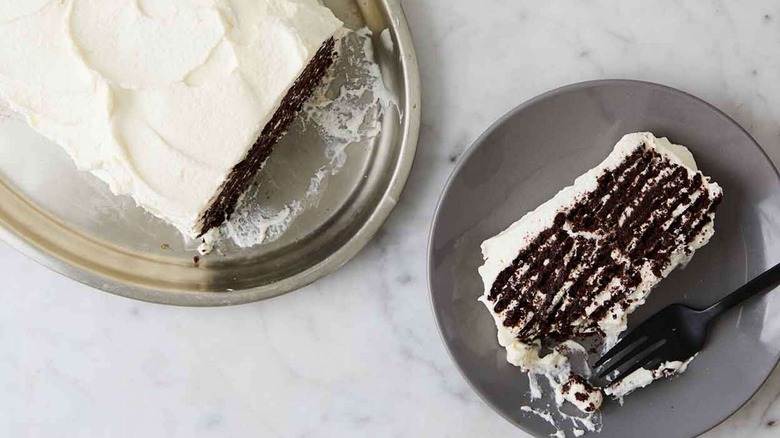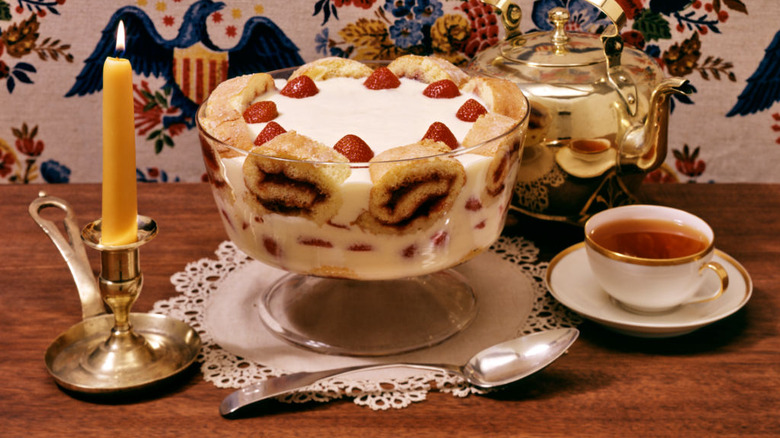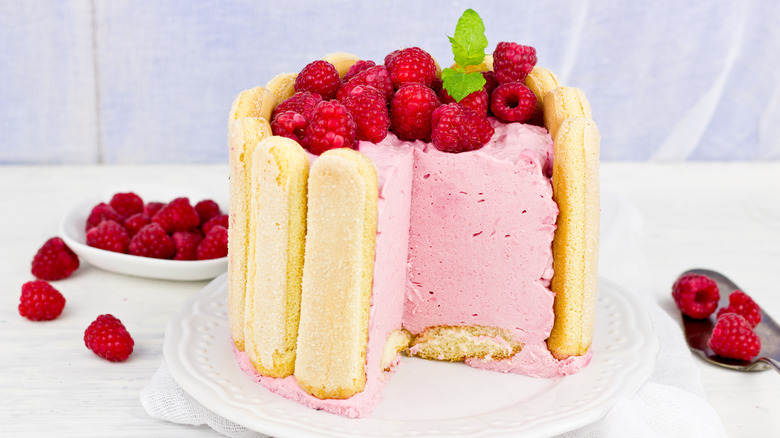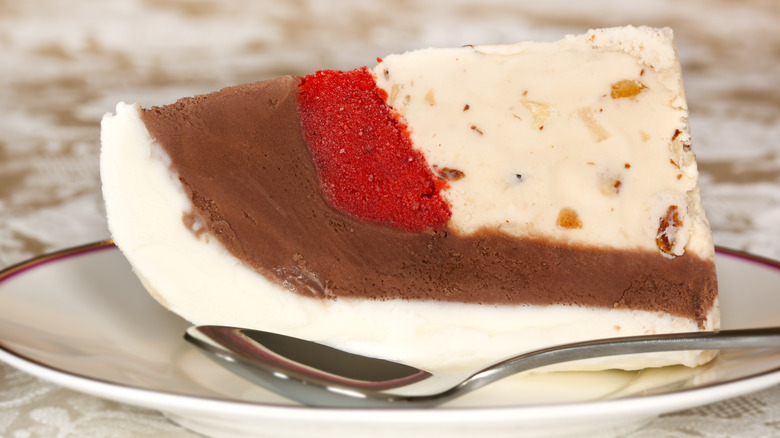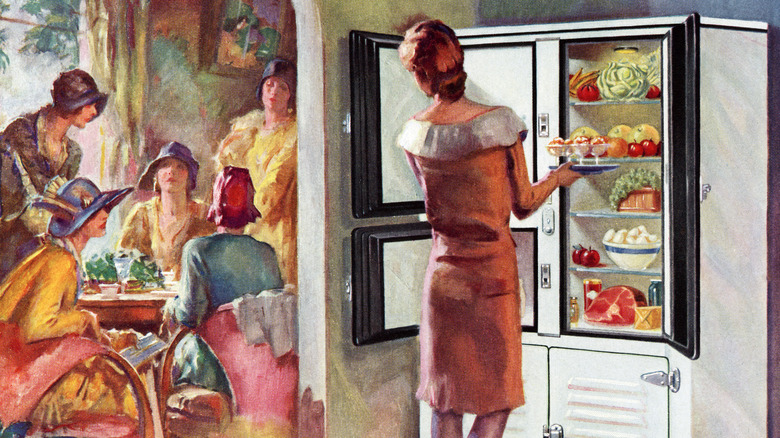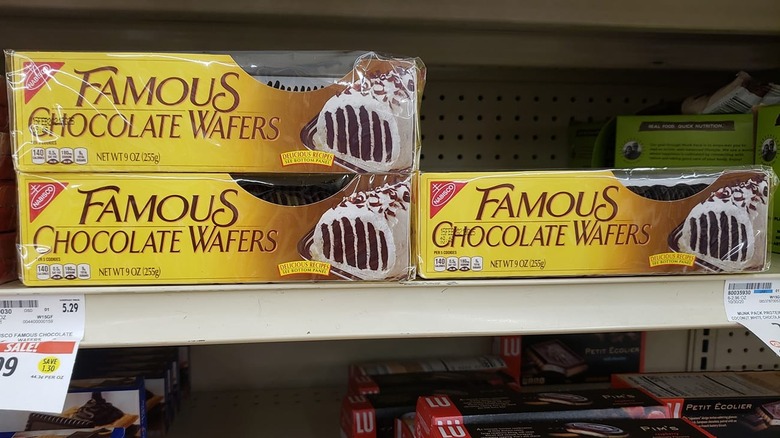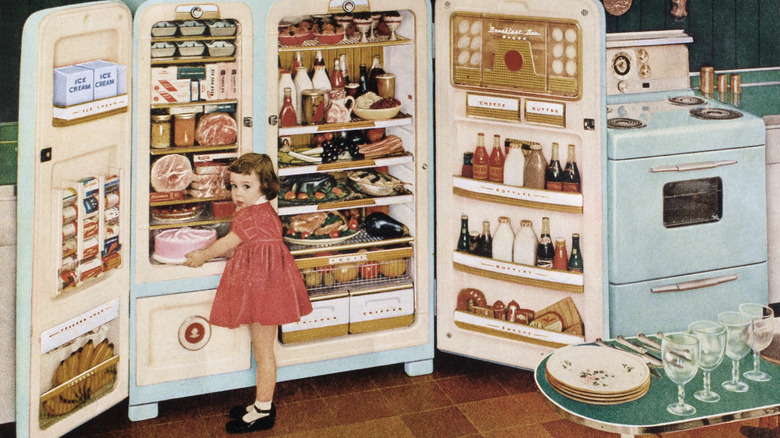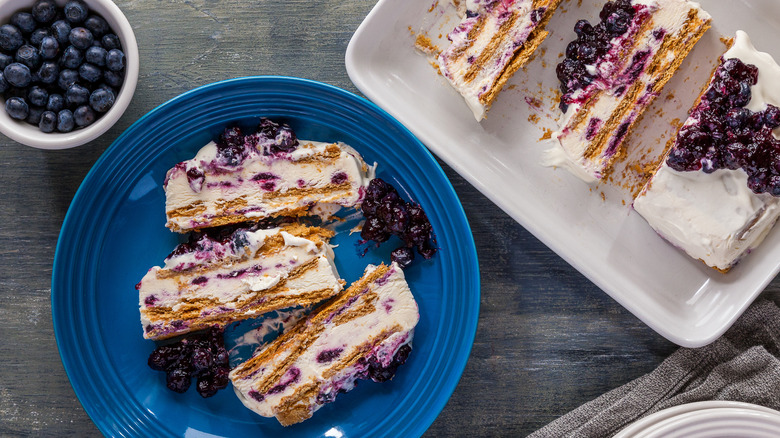The History Of The American Classic Icebox Cake
While the icebox cake technically refers to any cake that requires refrigeration before serving, many associate the name with one delectably simple retro recipe, which calls for nothing more than layers of whipped cream and chocolate wafers.
Like many iconic American culinary delights, a classic icebox cake is the product of an effective advertising scheme, though this sweet treat came together as a combination of novel culinary innovations. Once a dessert that reflected the peak of modernity and the utmost of convenience, it has slowly transformed into a nostalgic favorite. Though there is still margin for error, whether dressing it up or keeping it simple, an icebox cake will always taste good even if it doesn't turn out pretty.
But the classic cookies and cream confection didn't come from out of nowhere; it is the legacy of chilled desserts that gained popularity in the late 1800s, as refrigeration became increasingly more reliable and desirable. Part English trifle, part French charlotte, and really more of a pudding than a cake, the classic icebox cake became more widespread than any of its predecessors because of its simplicity — anyone can make one, and everyone enjoys them.
First came the trifle
The icebox cake comes from a long line of layered desserts, of which the English trifle is one of the earliest examples. This dessert, also referred to as the crème Anglaise, got its start during the Renaissance as an elaborate pudding — thickened sweet cream seasoned with ginger and rosewater. By the 1700s, the trifle had evolved to incorporate many other ingredients. Often combining sponge cake, macaroons, or almond ratafia biscuits, these desserts were layered with custard, fruit, and syllabub (a thick whipped cream), making for an elegant pile of sweetness.
The trifle continued to gain popularity in the 19th century, and was a favorite of waste-not-want-not Victorian cuisine. Though the trifle was just as often made from scratch, many Victorian-era trifles were simply the ingenuitive result of ensuring all leftovers were used up. Stale cake was soaked in sherry or wine and layered with leftover custards, the whole thing topped with any extra whipped cream that would otherwise go to waste without refrigeration.
A similar confection that arose in Europe during the 1800s was an Italian rendition called zuppa inglese ("English soup"), which nods to the English trifle. Though the ingredients are similar, zuppa inglese is served on a plate rather than in a large bowl, giving this Italian trifle something closer to the appearance of a cake than its English counterpart. A 1955 article from the New York Times places both zuppa inglese and English trifles under the same dessert category of "icebox cakes."
Then came the charlotte
Sandwiched between the birthplace of the trifle and the home of zuppa inglese, a French chef developed his own take on a biscuits and cream dessert that may be a more direct descendent of the icebox cake, as it had to be served chilled.
Marie-Antoine Carême, who cooked for Europe's royal families in the early 19th century, was a pioneer of French cuisine and is credited as the inventor of the charlotte russe (which translates to "Russian charlotte" in French). This was an unbaked take on the charlotte, another popular English dish typically served hot. While the most popular English baked version, the apple charlotte, fills a bread-lined cake pan with sliced apples and suggests a lava cake once turned over, Carême's cold charlotte russe borrows from the trifle, consisting of ladyfinger cookies lining a filling of Bavarian cream.
Rumor has it that Carême renamed the dish in honor of one of his later employers, Czar Alexander of Russia, as the dessert was originally known as charlotte à la parisienne. Still more distinctly a pudding but shaped like a cake, the charlotte russe is, for all intents and purposes, a primitive icebox cake. Amusingly enough, Carême is said to have introduced this chilled dessert in 1802, the same year that the icebox was invented, though this American innovation wouldn't become mainstream until years later.
Ice made the icebox cake
A growing taste for cold things turned ice into a household commodity. Before the ice box, ice was cut from frozen ponds and rivers and stored in underground pits, which offered enough insulation to keep ice blocks chilled for months. Considering the construction and maintenance of an ice pit was a sizeable undertaking, only households with ample means had one. That is, until Philadelphia farmer Thomas Moore, wanting to keep his butter chilled en route to the market, changed how ice could be stored with his invention of the icebox, for which Thomas Jefferson granted him a patent in 1803.
The concept was simple, but effective: a wooden box lined with zinc or tin and insulated with things like straw, cork, or sawdust. These insulated boxes became widespread kitchen appliances by the mid-19th century, contributing to an increased demand for chilled foods. More well-to-do households could show off with chilled meals, and homemade ice cream was a desired show of affluence.
Victorian iced creams were thickened creams and custards chilled until frozen. These were often shaped into elaborate molds, until the ice cream cake surpassed these confections in popularity. Ice cream bombes (or bombes glacées) were "cakes" made of rounded layers of ice cream, usually atop a biscuit, cake, or crust base — the Baked Alaska, for instance, became a popular dinner party showstopper. Served cold, these cakes were kept in the ice box, making them the first true icebox cakes.
A thoroughly modern dessert
The icebox expanded the possibilities for desserts and made chilled delicacies an accessible luxury for many more households. Consequently, cookbooks of the time period expanded to incorporate entirely new categories of sweets. For example, the 1909 edition of "The Good Housekeeping Woman's Home Cook Book," arranged by Isabel Gordon Curtis, dedicates two entirely separate sections to "cold desserts" and "frozen desserts," set apart from hot desserts and traditional baked goods.
It wasn't until the 1920s, however, that iceboxes truly became affordable, creating a demand that led to more inventions that would eventually replace the icebox entirely with the refrigerator. By the 1930s, icebox cakes continued to gain popularity as refrigerator brands aiming to sell their "electric iceboxes" enticed buyers with recipe pamphlets for chilled desserts. "They [wanted] people to value the refrigerator," American food historian Megan Elias told NPR. "So they [had] to kind of create a new cuisine that [made] people think of the refrigerator as indispensable."
Meanwhile, another edible innovation was on the rise. Since 1898, a few well-known baking brands had merged into the National Biscuit Company. Also known as Nabisco, the corporation spent the next few decades developing technology to wrap and package its mass-produced biscuit products, another new convenience that would turn packaged cookies into a modern pantry staple, eliminating the need to pre-bake biscuits for trendy new icebox recipes. It was Nabisco's advertising that greatly popularized the icebox cake by crafting a craving for a modern dessert.
Nabisco changed chilled desserts
Nabisco eventually mastered the art of packaging to ensure commercially produced biscuits wouldn't go stale, which gave the company somewhat of a monopoly on pre-packaged foods. Though Nabisco made its mark introducing Oreos to the world in 1912, it wasn't until 1924 that the brand introduced its Famous Chocolate Wafers; sold in a single sleeve, they were reminiscent of the Oreo biscuit.
In 1929, Nabisco included a recipe for icebox cake on the box of their Famous Chocolate Wafers, a combination of chocolate biscuits layered with whipped cream and chilled overnight before serving. While nothing about the ingredients suggests that this zebra-striped "icebox cake" is actually a cake, the whipped cream softens the wafers to a cake-like consistency, similar to the bread of an ice cream sandwich, thereby generating cake layers with no baking required. The no-bake nature of this easy to assemble dessert made it immensely popular.
Refrigerated desserts like Nabisco's icebox cake were a simplified version of the more complex charlotte russe, ultimately becoming a chilled dessert more accessible to middle class cooks. Though this box recipe was just as much a ploy to sell more chocolate biscuits, Nabisco's icebox cake did affirm that chilled desserts could be enjoyed in any home, since its assembly was so simple anyone could make it. The cake's cookies and cream flavor has become such a timeless classic that many associate Nabisco's zebra cake exclusively with the definition of an icebox cake.
A midcentury resurgence
Modernized to fit the times, icebox cakes, also called "refrigerator cakes," made a comeback in the 1950s, the era of convenience cooking that sought ultimate speed and efficiency in the kitchen.
Icebox cakes fit the expectations of this cultural moment well, producing a tasty and refreshing outcome with very minimal effort. With the midcentury introduction of cake mixes, instant puddings, and canned frosting to the convenience cook's pantry arsenal, the icebox cake got a facelift to become more than a mere nostalgic dessert. Expanding far beyond the classic chocolate and whipped cream combination that started this trend, zealous home cooks went on to widen the definition of icebox cake even further by adding creative layers and textures through the incorporation of different flavors of pudding, biscuits, ice cream, whipped cream, and candied fruit into their versions.
But beyond a resurgence in home recipes for refrigerated cakes, the '50s also saw the emergence of a new sort of ready-made icebox cake. This was the era that introduced Baskin Robbins ice cream, which catered to sweet tooths nationwide, offering more ice cream flavors than previously imaginable, shortly followed by ready-made and made-to-order ice cream cakes. While today's ice cream cake may be an elaborate deviation more in line with the charlotte russe and ice cream bombe that defined the 19th century's taste for chilled desserts, it has proven the versatility and endless possibilities for icebox cakes in any and all forms.
A new era for the icebox cake
While icebox cakes may be less of a novelty these days, they're still a nostalgic summer favorite, and traditionalists have a passionate preference for the classic zebra recipe. A Nabisco Famous Chocolate Wafers Fan Club Facebook group has been fangirling for years, but has in recent years been voicing concern over how difficult it has been to find these classic chocolate wafers.
Earlier this year, Nabisco validated these concerns by revealing that it has discontinued its Famous Chocolate Wafers. Though this unexpected disappearance has only galvanized that loyal fan base, the product, according to the company, isn't a big enough seller to continue production. There may be a slew of competing chocolate wafer brands available, and many icebox cake aficionados have tried to replicate the original with homemade recipes, but true fans proclaim (and lament) that Nabisco's chocolate wafers were the best.
The Famous Chocolate Wafers may be gone for good, but they certainly lived up to their name for nearly 100 years, and their disappearance only seems to have brought to light how the icebox cake remains a beloved dessert. A new generation has found great appeal in this retro concoction that requires no baking prowess other than the art of layering. An arsenal of inspiring TikTok videos has given Gen Z its own appreciation for the icebox cake — as ever, the beauty is in its simplicity.
